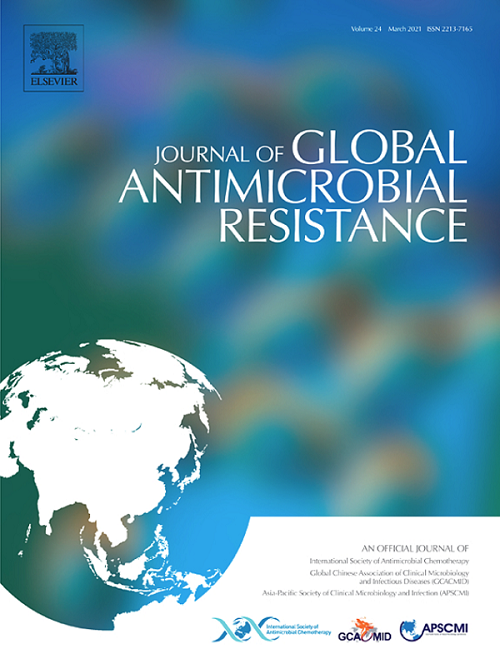Cefiderocol susceptibility of Stenotrophomonas maltophilia species complex and carbapenem-resistant Pseudomonas aeruginosa isolates from blood cultures at a university hospital in Tokyo, Japan
IF 3.2
3区 医学
Q2 INFECTIOUS DISEASES
引用次数: 0
Abstract
Objective
Cefiderocol, a siderophore cephalosporin, has shown promise against carbapenem-resistant strains such as Pseudomonas aeruginosa and Stenotrophomonas maltophilia species complex. Despite its recent approval in Japan, susceptibility data remain limited. Therefore, this study evaluated the cefiderocol susceptibility of carbapenem-resistant P. aeruginosa and S. maltophilia species complex strains isolated from blood cultures to determine whether cefiderocol can be used as an empirical treatment option.
Methods
Carbapenem-resistant P. aeruginosa and S. maltophilia species complex strains isolated from blood cultures at a university hospital in Japan were included. Minimum inhibitory concentrations (MICs) and inhibition zone diameters were assessed using broth microdilution and disk diffusion methods, respectively. Whole-genome sequencing was conducted to elucidate the genetic backgrounds of the clinical isolates.
Results
The MIC50 and MIC90 values for cefiderocol in 65 carbapenem-resistant P. aeruginosa strains were 0.12 and 0.25 µg/mL, and 0.06 and 0.25 µg/mL for 51 S. maltophilia species complex strains, respectively. One S. maltophilia species complex strain exhibited non-susceptibility, with a MIC of 2 µg/mL in broth microdilution, while disk diffusion methods demonstrated susceptibility. A significant negative correlation was observed between MIC values and inhibition zone diameters. Whole-genome sequencing revealed that a limited number of P. aeruginosa strains possessed carbapenemase genes.
Conclusions
The findings of this study support the efficacy of cefiderocol against carbapenem-resistant P. aeruginosa and S. maltophilia species complex, suggesting its potential as an empirical treatment option for bloodstream infection patients in Japan. Continued surveillance is advised to monitor resistance trends with increased cefiderocol use.
日本东京某大学医院血培养嗜麦芽窄养单胞菌复合物和耐碳青霉烯铜绿假单胞菌对头孢地洛尔的敏感性
目的:头孢地罗是一种含铁的头孢菌素,对碳青霉烯耐药菌株如铜绿假单胞菌和嗜麦芽寡养单胞菌具有良好的抗氧化作用。尽管该药最近在日本获得批准,但其敏感性数据仍然有限。因此,本研究评估了从血培养中分离出的耐碳青霉烯P. aeruginosa和嗜麦芽链球菌复合菌株对头孢地醇的敏感性,以确定头孢地醇是否可以作为经验性治疗选择。方法:选取日本某大学医院血培养的耐碳青霉烯铜绿假单胞菌和嗜麦芽葡萄球菌复合菌株。最低抑菌浓度(mic)和抑菌区直径分别采用肉汤微量稀释法和圆盘扩散法进行评估。采用全基因组测序分析临床分离株的遗传背景。结果:65株耐碳青霉烯P. aeruginosa菌株对头孢醚醇的MIC50和MIC90分别为0.12µg/mL和0.25µg/mL, 51株嗜麦芽葡萄球菌复合菌株对头孢醚醇的MIC50和MIC90分别为0.06µg/mL和0.25µg/mL。一株嗜麦芽葡萄球菌复合菌株在肉汤微稀释条件下的MIC为2µg/mL,无敏感性,而圆盘扩散法表现出敏感性。MIC值与抑制带直径呈显著负相关。全基因组测序显示,有限数量的铜绿假单胞菌菌株具有碳青霉烯酶基因。结论:本研究结果支持头孢地罗对耐碳青霉烯P. aeruginosa和嗜麦芽葡萄球菌物种复合物的疗效,提示其有潜力作为日本血液感染患者的经经验治疗选择。建议继续监测随着头孢地罗使用增加而出现的耐药性趋势。
本文章由计算机程序翻译,如有差异,请以英文原文为准。
求助全文
约1分钟内获得全文
求助全文
来源期刊

Journal of global antimicrobial resistance
INFECTIOUS DISEASES-PHARMACOLOGY & PHARMACY
CiteScore
8.70
自引率
2.20%
发文量
285
审稿时长
34 weeks
期刊介绍:
The Journal of Global Antimicrobial Resistance (JGAR) is a quarterly online journal run by an international Editorial Board that focuses on the global spread of antibiotic-resistant microbes.
JGAR is a dedicated journal for all professionals working in research, health care, the environment and animal infection control, aiming to track the resistance threat worldwide and provides a single voice devoted to antimicrobial resistance (AMR).
Featuring peer-reviewed and up to date research articles, reviews, short notes and hot topics JGAR covers the key topics related to antibacterial, antiviral, antifungal and antiparasitic resistance.
 求助内容:
求助内容: 应助结果提醒方式:
应助结果提醒方式:


